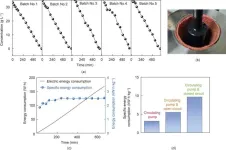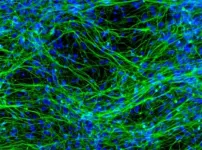(Press-News.org)
Researchers have made significant progress in the development of artificial neural networks using tiny silicon devices called microresonators, paving the way for faster and more energy-efficient artificial intelligence systems. These networks mimic the computing capabilities of the human brain, breaking away from traditional digital computer architectures and leveraging the speed, low power dissipation and multi-wavelength capabilities of photonics.
A review article describing the implementations of neural networks using silicon microresonators was published Jan. 16 in Intelligent Computing, a Science Partner Journal.
Silicon microresonators are tiny structures that trap and confine light. Silicon microring resonators are loop-like microresonators that guide light in a circular path. In optical systems, they can trap light and change its intensity, allowing precise control of the properties of the light, such as its frequency, phase and amplitude. These resonators could be applied in optical communications and sensing.
One useful feature of microring resonators is their ability to store high field intensity, which enhances the light-matter interaction. This makes the nonlinear response available at relatively low power, allowing them to mimic biological neurons. When the energy level of the light is low, microring resonators behave predictably, responding to the input light linearly. This means that if the light input increases, the output light increases proportionally. However, at higher energy levels, microring resonators enter a nonlinear regime, meaning the output or the behavior of the light does not change in direct proportion to the input. This is because the light itself starts to affect the properties of the material, such as its refractive index and its ability to absorb light.
In biological neurons, input signals are received, processed and transformed into output signals. This transformation is often nonlinear because a neuron might suddenly fire when the input reaches a certain threshold. Because the way that microring resonators change the behavior of light is similar to how our brain cells work, they can be used to emulate neural activity in artificial neural networks.
Another useful feature of microring resonators is their sensitivity to wavelength, which allows them to serve as weight banks. In artificial neural networks, weights are parameters that determine the strength of the connections between neurons, influencing the flow of information and the ability of the network to learn complex patterns. Silicon microring resonators can act as weight banks in photonic neural networks. They work by controlling how much of an incoming light signal gets through, depending on its wavelength. This control allows microring resonators to adjust the "weight" of each incoming light signal and is crucial for learning and adapting in neural networks. The range of these weights depends on how well the microring resonators can block light, which is determined by their design and the materials they are made from.
Additionally, silicon microring resonators can be used in devices along with other materials to enhance their properties and functionalities. These hybrid devices aim to improve the performance of photonic artificial neurons and activation functions by leveraging the sensitivity of microring resonators to wavelength changes.
The integration of silicon microresonators into artificial neural networks represents a significant leap forward in the field of artificial neural networks. With their unique properties and potential for scalability, microresonators offer a promising platform for developing more efficient and powerful artificial intelligence systems that mimic the processing capabilities of the human brain. The combination of the speed and low power consumption of photonics with the versatility and precision of silicon microresonators will open up new possibilities for artificial intelligence applications.
END
Scientists develop a simple blood test to quickly diagnose sarcoidosis
NIH-funded tool can accurately identify the potentially life-threatening inflammatory disease
A research project supported by the National Institutes of Health has developed a tool to rapidly and inexpensively diagnose sarcoidosis, a chronic inflammatory disease marked by the growth of tiny lumps called granulomas in the lungs and other organs in the body. The tool, which uses a simple blood test, could allow for selective use of more invasive diagnostic tests often used to identify the ...
A research team at Tsinghua University led by Professor Huijuan Liu has developed a new electrochemical system that promises to revolutionize metal recovery from industrial wastewater. The research was published in Engineering.
Industrial wastewater poses significant environmental hazards due to heavy metal pollution. Current methods for metal recovery, such as electrodeposition, suffer from interfacial ion transport limitations, resulting in slow and low-quality recovery. In their study, the team proposed a novel approach that integrates a transient electric field (TE) and swirling flow (SF) to improve mass transfer and promote interfacial ...
In a groundbreaking study, Professor Won-Jin Kwak in the School of Energy and Chemical Engineering at UNIST, in collaboration with researchers from Hanyang University, have pioneered a method to significantly enhance the performance and lifespan of organic electrode-based batteries. The findings promise to accelerate the commercialization of eco-friendly batteries and pave the way for further advancements in the field.
Organic electrodes have long been recognized for their cost-effectiveness and natural abundance, making them a promising alternative to traditional lithium-ion battery ...
BGI Europe A/S, a wholly owned subsidiary of BGI Genomics, announced its NIFTY® non-invasive prenatal testing kit and software (CE-IVDD List B) were granted an extension under its existing CE-IVDD certification to include the DNBSEQ-G99 model to meet the European Union regulations for medical devices.
In January 2024, BGI Genomics unveiled the NIFTY® ultra-fast non-invasive prenatal genetic testing product, utilizing the innovative DNBSEQ-G99 platform. Designed for both small and medium throughput, this platform ensures top-notch testing ...
Living in neighborhoods with high levels of violence can affect children’s development by changing the way that a part of the brain detects and responds to potential threats, potentially leading to poorer mental health and other negative outcomes, according to research published by the American Psychological Association.
However, nurturing parents can help protect kids against these detrimental effects, according to the study, published in the journal Developmental Psychology.
“Decades of research ...
A groundbreaking technology that can recognize human emotions in real time has been developed by Professor Jiyun Kim and his research team in the Department of Material Science and Engineering at UNIST. This innovative technology is poised to revolutionize various industries, including next-generation wearable systems that provide services based on emotions.
Understanding and accurately extracting emotional information has long been a challenge due to the abstract and ambiguous nature of human affects such as emotions, ...
HOUSTON ― The University of Texas MD Anderson Cancer Center today announced it has acquired certain assets from Bellicum Pharmaceuticals, Inc. related to the CaspaCIDe® switch platform and the GoCAR® platform. The transaction also includes clinical-grade stocks of rimiducid, an agent used to trigger the switches.
As a result of this acquisition, MD Anderson may incorporate these platforms into its own cell therapy programs. The institution also intends to make the technology ...
From Bangladesh to India to Texas, Tom Varner is leveraging his research to improve sources for drinking water around the world.
Varner, a UTSA doctoral student in environmental science and engineering, explored the mobility of arsenic from the sediments surrounding the Meghna River in Bangladesh as part of a National Science Foundation-funded project.
The river flows through central Bangladesh, where elevated concentrations of arsenic in the groundwater threaten the welfare of millions of people. Long-term exposure to arsenic, which is toxic when ingested, can lead ...
A large-scale clinical trial of treatment strategies for Crohn’s disease has shown that offering early advanced therapy to all patients straight after diagnosis can drastically improve outcomes, including by reducing the number of people requiring urgent abdominal surgery for treatment of their disease by ten-fold.
The PROFILE trial, led by researchers at the University of Cambridge, involved 386 patients with newly-diagnosed active Crohn’s disease. Recruiting from 40 hospitals across the UK, and supported by the National Institute for Health and Care Research (NIHR) Clinical Research Network, it sought to test whether a biomarker – a genetic signature ...
Anxiety-related disorders can have a profound impact on the mental health and quality of life of affected individuals. Understanding the neural circuits and molecular mechanisms that trigger anxiety can aid in the development of effective targeted pharmacological treatments. Delta opioid receptors (DOP), which localize in the regions of the brain associated with emotional regulation, play a key role in the development of anxiety. Several studies have demonstrated the therapeutic effects of DOP agonists (synthetic compounds which selectively bind to DOPs and mimic the effect of ...





